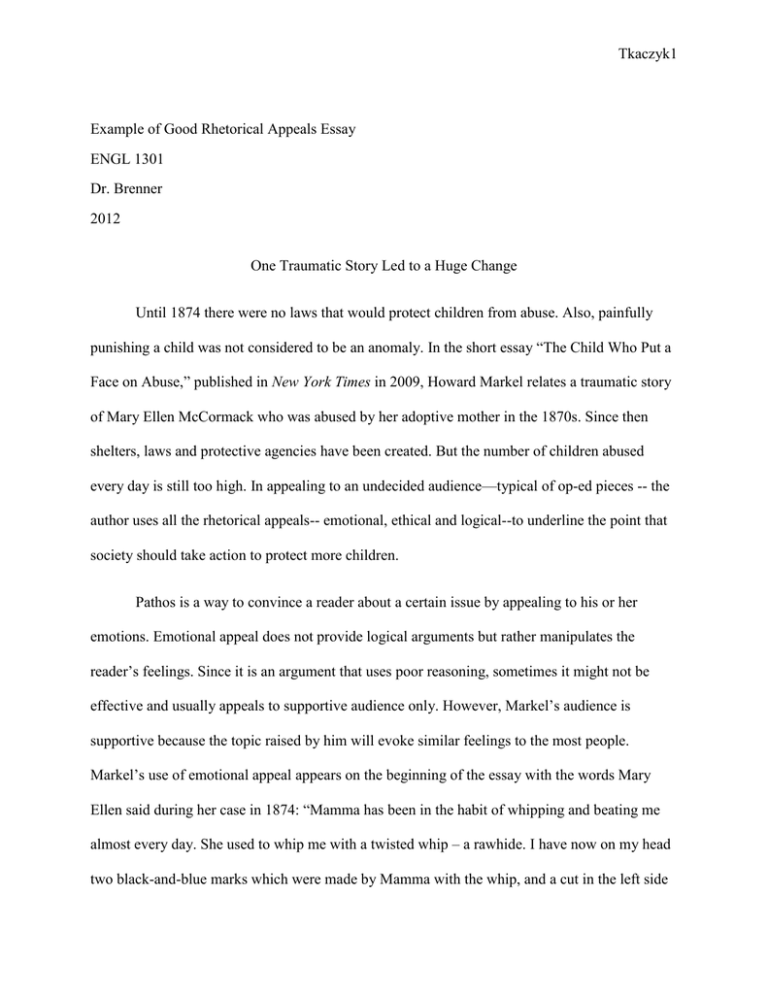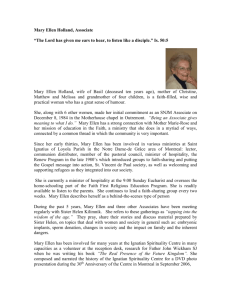HD_Sample_RAAE_1301_DR.doc
advertisement

Tkaczyk1 Example of Good Rhetorical Appeals Essay ENGL 1301 Dr. Brenner 2012 One Traumatic Story Led to a Huge Change Until 1874 there were no laws that would protect children from abuse. Also, painfully punishing a child was not considered to be an anomaly. In the short essay “The Child Who Put a Face on Abuse,” published in New York Times in 2009, Howard Markel relates a traumatic story of Mary Ellen McCormack who was abused by her adoptive mother in the 1870s. Since then shelters, laws and protective agencies have been created. But the number of children abused every day is still too high. In appealing to an undecided audience—typical of op-ed pieces -- the author uses all the rhetorical appeals-- emotional, ethical and logical--to underline the point that society should take action to protect more children. Pathos is a way to convince a reader about a certain issue by appealing to his or her emotions. Emotional appeal does not provide logical arguments but rather manipulates the reader’s feelings. Since it is an argument that uses poor reasoning, sometimes it might not be effective and usually appeals to supportive audience only. However, Markel’s audience is supportive because the topic raised by him will evoke similar feelings to the most people. Markel’s use of emotional appeal appears on the beginning of the essay with the words Mary Ellen said during her case in 1874: “Mamma has been in the habit of whipping and beating me almost every day. She used to whip me with a twisted whip – a rawhide. I have now on my head two black-and-blue marks which were made by Mamma with the whip, and a cut in the left side Tkaczyk2 of my forehead which was made by a pair of scissors in Mamma’s hand; she struck me with scissors and cut me. . . . I never dared to speak to anybody, because if I did I would get whipped” (par. 1). He makes the reader to strongly feel emotions of shock and pity from the very beginning. It also introduces the reader to the topic and helps to connect with the story and author’s message. Markel creates the emotional appeal from the first sentence and continues throughout the essay describing Mary Ellen’s life and discussing children’s rights being created, but he states his thesis at the end. This specific way of presenting the problem prepares his reader for the point that, “how much our society values its children can be measured only by how well they are treated and protected” (par.12). Markel states his thesis at the end because the emotions he evokes in readers will probably cause them to feel differently about the issue after reading his essay and see it from a different perspective. Ethical appeal is a credibility appeal. An author uses the ethical appeal when he presents himself as an authority figure who is well educated and knows much about a subject. Ethical appeal is another of the appeals Howard Markel included in his work. First of all, he is a physician and a writer whose work is well-known in many countries. He is well-educated – he has a doctoral degree in history of science, medicine and technology. And second of all, he has some knowledge about child abuse and specifically the case of Mary Ellen. For example, in the second paragraph, when he is explaining why Mary Ellen’s words may sound familiar to some people, he mentions the movie Precious, which, he says: “depicts the emotional and sexual abuse of a Harlem girl” (par.2). This means that he knows more about child abuse than just the Mary Ellen’s story. And also later in the fourth paragraph he gives a little bit of background information about Ellen’s case and the way children were treated at that time which again proves his knowledge about the subject. Tkaczyk3 Logical appeal is persuasion through logic, evidence or facts. The quote of Mary Ellen’s words that appeared in the first paragraph is an example of the emotional appeal and also serves as evidence. In the text, the author is mainly telling the story of Mary Ellen’s life and the process of fighting for children’s rights. Although Mary Ellen’s story is shocking and evokes strong emotions, the author is telling it in a formal, calm tone. It is not the way Markel is telling her story that causes the reader to react emotionally but the traumatic events that happened in Mary Ellen’s life and everything she went through. It may evoke emotional reaction in a reader and more sensitive readers may not even want to believe in the story Markel is relating. But the author provides a picture of Mary Ellen, what also works as evidence and emphasizes authenticity of the story. First reading the words she said during her case, then looking at her sad eyes and multiple cuts on her legs and face is heart-wrenching for the audience, yet it starts to build a big picture in reader’s mind of how cruel was the way the little girl was treated. The audience can better understand the author’s point of view and the girl’s situation. The picture also matches with description of Mary Ellen in the New York Times article which was published after the lawsuit in 1874: “Her apparent condition of health, as well as her scanty wardrobe, indicated that no change of custody or condition could be much for the worse” (par. 8). The quote, picture and description in the article create a whole that strongly and logically communicates the author’s message. Even though at first it seemed to me that the author is using mainly emotional appeal, all the appeals were used in the text and they work well together. The logical appeal balances the emotional appeal. The emotions that reader experiences while reading the text do not come from being manipulated by the reader but the story itself, which is what makes this essay successful.


